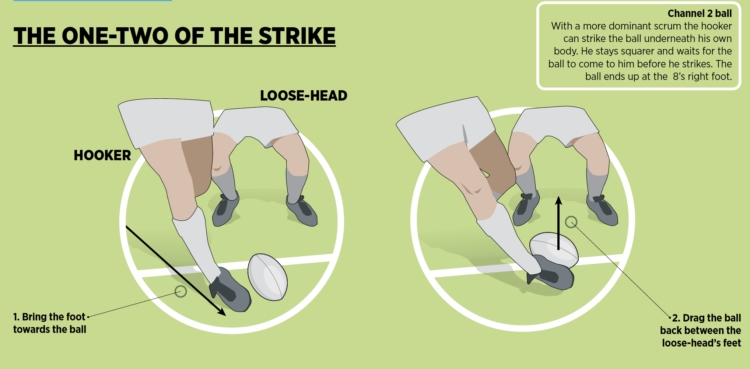Strike better as a hooker
Scrums & Lineoutsby Danny Wilson
The new scrum laws mean we know what to expect. The hooker’s under more pressure and he has to strike the ball cleanly. Here’s how to bind up more comfortably and hook quicker.

Unless you have a dominant scrum, you can’t “walk over” the ball on the put-in and the referee must see (if they can!) an attempt to strike the ball. Hookers need to learn to “hook” .
They must strike the ball cleanly and retain a strong scrummaging position straight afterwards.
The hooker sets the mark for the scrum, with his striking foot forward. We call this the brake foot because it keeps the rest of the front row balanced as it leans forward.
On “set”, the brake foot goes back. It is ready to come forward to strike the ball.
The hooker binds over the backs of his two props, with the top of his body square. Hookers will tend to either bind just under the armpits or the shoulders of their props. He doesn’t want to get hunched and lose his strong shape.
If you look at the bound-up front row, you should see six shoulders. The binding should allow that to happen. While the shoulders are square, the hooker’s lower body has to be able to twist. First, to strike for the ball, second, to get back quickly into position to push.
The striking foot moves through two sides of a triangle. First, the foot comes out and towards the ball. Then, it drags the ball back through the legs of the loose-head (also see “channel 2” above).
To do this, the hips have to be open, and not square. This isn’t a comfortable position, so he shouldn’t twist until the last moment.
Normally, the 9 touches the hand of the 2 and then the ball is put-in. That works better than the hooker flapping his hand, because there isn’t a verbal signal from the referee any more.



Unless you have a dominant scrum, you can’t “walk over” the ball on the put-in and the referee must see (if they can!) an attempt to strike the ball. Hookers need to learn to “hook” .
They must strike the ball cleanly and retain a strong scrummaging position straight afterwards.
BRAKE FOOT
The hooker sets the mark for the scrum, with his striking foot forward. We call this the brake foot because it keeps the rest of the front row balanced as it leans forward.
On “set”, the brake foot goes back. It is ready to come forward to strike the ball.
BINDING TO KEEP SQUARE
The hooker binds over the backs of his two props, with the top of his body square. Hookers will tend to either bind just under the armpits or the shoulders of their props. He doesn’t want to get hunched and lose his strong shape.
If you look at the bound-up front row, you should see six shoulders. The binding should allow that to happen. While the shoulders are square, the hooker’s lower body has to be able to twist. First, to strike for the ball, second, to get back quickly into position to push.
STRIKE THE TRIANGLE
The striking foot moves through two sides of a triangle. First, the foot comes out and towards the ball. Then, it drags the ball back through the legs of the loose-head (also see “channel 2” above).
To do this, the hips have to be open, and not square. This isn’t a comfortable position, so he shouldn’t twist until the last moment.
Normally, the 9 touches the hand of the 2 and then the ball is put-in. That works better than the hooker flapping his hand, because there isn’t a verbal signal from the referee any more.


Related Files
strike-better-as-a-hooker.pdfPDF, 588 KB
Newsletter Sign Up
Coaches Testimonials

Gerald Kearney, Downtown Las Vegas Soccer Club

Paul Butler, Florida, USA

Rick Shields, Springboro, USA

Tony Green, Pierrefonds Titans, Quebec, Canada
Subscribe Today
Be a more effective, more successful rugby coach
In a recent survey 89% of subscribers said Rugby Coach Weekly makes them more confident, 91% said Rugby Coach Weekly makes them a more effective coach and 93% said Rugby Coach Weekly makes them more inspired.
Get Weekly Inspiration
All the latest techniques and approaches
Rugby Coach Weekly offers proven and easy to use rugby drills, coaching sessions, practice plans, small-sided games, warm-ups, training tips and advice.
We've been at the cutting edge of rugby coaching since we launched in 2005, creating resources for the grassroots youth coach, following best practice from around the world and insights from the professional game.












